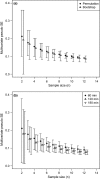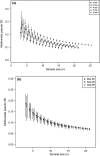Measures of precision for dissimilarity-based multivariate analysis of ecological communities
- PMID: 25438826
- PMCID: PMC4311441
- DOI: 10.1111/ele.12385
Measures of precision for dissimilarity-based multivariate analysis of ecological communities
Abstract
Ecological studies require key decisions regarding the appropriate size and number of sampling units. No methods currently exist to measure precision for multivariate assemblage data when dissimilarity-based analyses are intended to follow. Here, we propose a pseudo multivariate dissimilarity-based standard error (MultSE) as a useful quantity for assessing sample-size adequacy in studies of ecological communities. Based on sums of squared dissimilarities, MultSE measures variability in the position of the centroid in the space of a chosen dissimilarity measure under repeated sampling for a given sample size. We describe a novel double resampling method to quantify uncertainty in MultSE values with increasing sample size. For more complex designs, values of MultSE can be calculated from the pseudo residual mean square of a permanova model, with the double resampling done within appropriate cells in the design. R code functions for implementing these techniques, along with ecological examples, are provided.
Keywords: Assemblage data; community ecology; dissimilarities; multivariate analysis; permanova; precision; replicates; sampling design; standard error; variability.
© 2014 The Authors. Ecology Letters published by John Wiley & Sons Ltd and CNRS.
Figures



References
-
- Anderson MJ. A new method for non-parametric multivariate analysis of variance. Austral Ecol. 2001a;26:32–46.
-
- Anderson MJ. Permutation tests for univariate or multivariate analysis of variance and regression. Can. J. Fish. Aquat. Sci. 2001b;58:626–639.
-
- Anderson MJ. Distance-based tests for homogeneity of multivariate dispersions. Biometrics. 2006;62:245–253. - PubMed
-
- Anderson MJ. ter Braak CJF. Permutation tests for multi-factorial analysis of variance. J. Stat. Comput. Simul. 2003;73:85–113.
-
- Anderson MJ. Walsh DCI. What null hypothesis are you testing? PERMANOVA, ANOSIM and the Mantel test in the face of heterogeneous dispersions. Ecol. Monogr. 2013;83:557–574.
Publication types
MeSH terms
LinkOut - more resources
Full Text Sources
Other Literature Sources

